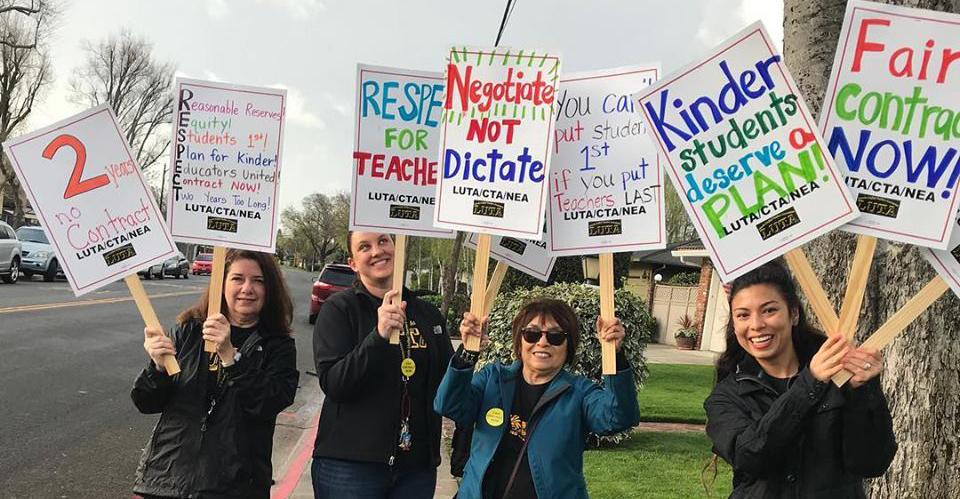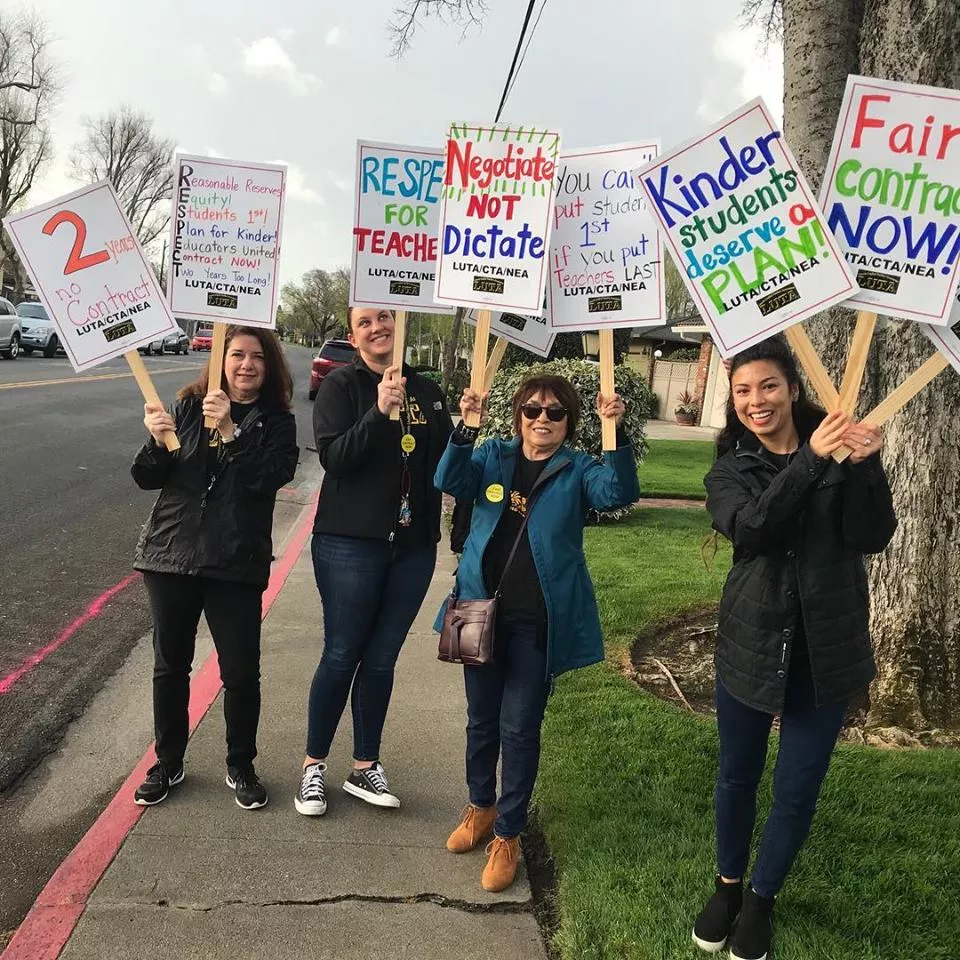 While educators from big cities—like Los Angeles, Oakland, and Denver—have garnered national attention for their massive strikes, walkouts, work stoppages, and rallies over student learning conditions, wages, and benefits, educators in smaller towns have been just as successful.
While educators from big cities—like Los Angeles, Oakland, and Denver—have garnered national attention for their massive strikes, walkouts, work stoppages, and rallies over student learning conditions, wages, and benefits, educators in smaller towns have been just as successful.
Take California’s Lincoln Unified Teachers Association (LUTA), a mid-sized local of nearly 500 members who mobilized, held informational pickets, packed school board meetings, worked bell-to-bell, and won big.
In April, after spending 15 months negotiating and two years without a contract, LUTA educators ratified a landmark contract that improves the learning conditions for all 9,400 students. Negotiations weren’t over wages and benefits, according to the California Educator—both sides came to an agreement on those a year ago. Instead, educators bargained for more music programs for kindergarten kids and the restoration of music instruction for third graders.
The contract also includes district-paid induction costs for new teachers, which help to recruit and retain committed teachers. For new teachers, this goes a long way.
“Being a new teacher is hard enough without having to pay extra costs,” says Angela Quitasol, a science teacher at Sierra Middle School. “I’m so grateful to get reimbursed for the fees that I’ve already paid and that I won’t have to pay any more next year.”
Additionally, each K-8 class districtwide will receive a “classroom budget” of no less than $400. This will cover classroom supplies needed for students to be successful. Previously the amount would vary: some classrooms received only $100 while others received $400.
Wins like these don’t happen overnight. It takes time and intentional effort to engage members. LUTA President Tiffany Fuhrmeister said to the California Educator that “the victory wouldn’t have been possible without the commitment of all LUTA educators to fighting side-by-side for each other, their students, and the Lincoln Unified community.”
And when Fuhrmeister says “all,” she means all.
‘Let’s Empower People’
With small local unions, it’s not uncommon for a handful of leaders to task themselves with all of the work. LUTA leaders, however, made a long-term investment and a commitment in making the local more democratic by empowering its members to run their own contract bargaining.
Two years ago, NEA’s Center for Organizing and the California Teachers Association partnered with a few northern Golden State locals to help develop campaigns around their contract negotiations. With guidance from the national and state affiliates, LUTA leaders shifted its negotiation’s structure to include more voices in their decision-making process. This included parents, education support professionals, and new teachers.
“We keep talking about this notion of collective action,” says Fuhrmeister, an elementary school teacher with nearly 20 years of experience. “There are all these people who want to get involved and have deep-rooted insight on what their students need. If we’re going to empower people, let’s empower people.”
Additionally, public forums were held, school-site visits were scheduled, and a campaign plan was built to address the concerns of parents and educators throughout the district.
“Having three or four people wasn’t enough. We expanded the bargaining team to 25 people. This allowed us to focus on school- and student-friendly platforms, as well as speak on behalf of our entire membership.”
Inclusivity and the openness to share leadership roles have gone a long way. Initially, during the first public forum in the spring of 2018, 120 LUTA members were in attendance—less than half of the overall membership. By fall of the same year, after the new bargaining format was adopted, a board action drew 350 members to the meeting.
What’s next for LUTA? With Election Day fast approaching, the local now has the experience to organize around upcoming school board elections, as well as state and federal races.
“A teachers’ union is only as strong as its members. We need to continue to know our worth, the worth of our students, and the worth of our profession,” Fuhrmeister said. “This is just the beginning of a new day at [Lincoln Unified School District].”
On the Opposite Side of the Country
With more than 950 students, the Newport School District in New Hampshire prides itself on its small-town flavor: school Halloween parades down Main Street; Homecomings at the high school and the bonfires that follow; and pancake breakfasts to salute veterans. But even small districts like these go through difficult contract negotiations.
Previously, members of the Newport Teachers Association (NTA), a local of nearly 100 members, would go one year with a contract and then without the following year.
This swaying pattern lasted ten years, until this past March, when the district, local, and the town’s voting bloc approved a three-contract. (In New Hampshire, collective-bargaining agreements require voter approval.)
The main issue was teacher pay. The yo-yo effect of the bargaining agreement created a lag in salaries. Teachers were between one and eight steps behind the salary schedule. For small locals like Newport, this is “crippling.”
At the start of the 2018-2019 school year, for example, the district saw a 33 percent teacher turnover (33 of 100 teachers left). Some of them were new teachers who left a few weeks after the school year started. These turnovers left huge gaps in special education and elementary school positions.
“Teachers would turn down jobs once they found out what they were going to get paid—despite their years of experience and credentials,” says Melissa Mitchler, a 22-year veteran math teacher and co-president of the local association. “This was crippling the district’s ability to hire. It was crippling our profession because over time we were losing money to rising health-care costs, and it was crippling our students, who struggled to connect with new teachers every year.”
What Changed After a Decade?
Similar to California’s Lincoln Unified Teachers Association, the Newport local began to plan and organize long before leaders met with the district and voters. NTA Co-Presidents Mitchler and Lisa Ferrigno, an elementary school teacher with 14 years of experience, recruited more rank-and-file members, as well as community members, to be involved in their negotiation efforts.
NEA-New Hampshire staff offered guidance and support every step of the way, including a fact-finding brief that was hard to disprove. Additionally, a partnership with American Votes helped the local create a solid campaign plan that included targeted post cards, walking sheets for door-knocking efforts, and visibility via lawn signs. The local's leadership attended select school board meeting, budget committee meeting, and took to the air waves to enlist public support.
Together, the trio launched a massive organizing effort that led to winning a three-year contract. The contract was its own item on the ballot, which included the school district budget and the collective-bargaining agreement for the Newport Support Staff Association. In March, more than 1,000 voters hit the polls. It was the largest voter turnout for a school budget vote on record, according to reports from district officials. NTA’s three-year agreement passed by 17 votes (629 to 612). The contract for support staff also passed and was a significant win.
The first-year cost of the contract, including salary and benefits is listed at $347,000. The second year is $301,000 and the last year is $140,000. At the end of the third year, all staff will be on a step that properly equates to their years of experience, instead of being one to eight steps behind.
“While this was momentous for the district, the association, and for our students,” says Ferrigno, “this is just the first step toward bringing our district pay closer in line with neighboring districts. We have more work to do to keep teachers in the profession, giving our students consistency in their education.”


